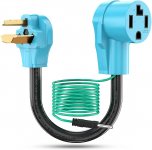EBQ
Member
- Location
- Northeastern US
So they sell these 4-prong <-> 3-prong adapters for 240V 30-amp dryers (see picture below). I assume they are non-code compliant to use, but from an electrical theory perspective, I have a few questions:

1. Assuming I plug the ground wire into the ground of a 20-amp outlet, the typical 20-amp circuit ground wire is only 12 AWG, but the 30-amp dryer ground requires 10 AWG, so this adapter is insufficient to handle dryer ground fault, am I wrong?
2. What if I split this ground and tie it to the ground wires of two separate 20-amp circuits, would that electrically/theoretically provide a good safety margin for 30-amp return in case of ground fault?
3. This gets me thinking if one bonded the chassis of a dryer and the chassis of a washer (plugged into a 20-amp outlet) sat next to each other (e.g., with a 10 AWG wire), would it accomplish #1 the same? And if one bonded the chassis of the dryer to another 20-amp circuit ground (in addition to the washer chassis), would it accomplish #2 the same?
4. If #2/3 is electrically/theoretically good enough for 30-amp fault currents, other than potential mechanical failures (accidental loosening etc), are there any electrical/theoretical concerns if everything remains in contact?
Thanks!

1. Assuming I plug the ground wire into the ground of a 20-amp outlet, the typical 20-amp circuit ground wire is only 12 AWG, but the 30-amp dryer ground requires 10 AWG, so this adapter is insufficient to handle dryer ground fault, am I wrong?
2. What if I split this ground and tie it to the ground wires of two separate 20-amp circuits, would that electrically/theoretically provide a good safety margin for 30-amp return in case of ground fault?
3. This gets me thinking if one bonded the chassis of a dryer and the chassis of a washer (plugged into a 20-amp outlet) sat next to each other (e.g., with a 10 AWG wire), would it accomplish #1 the same? And if one bonded the chassis of the dryer to another 20-amp circuit ground (in addition to the washer chassis), would it accomplish #2 the same?
4. If #2/3 is electrically/theoretically good enough for 30-amp fault currents, other than potential mechanical failures (accidental loosening etc), are there any electrical/theoretical concerns if everything remains in contact?
Thanks!
Last edited:

